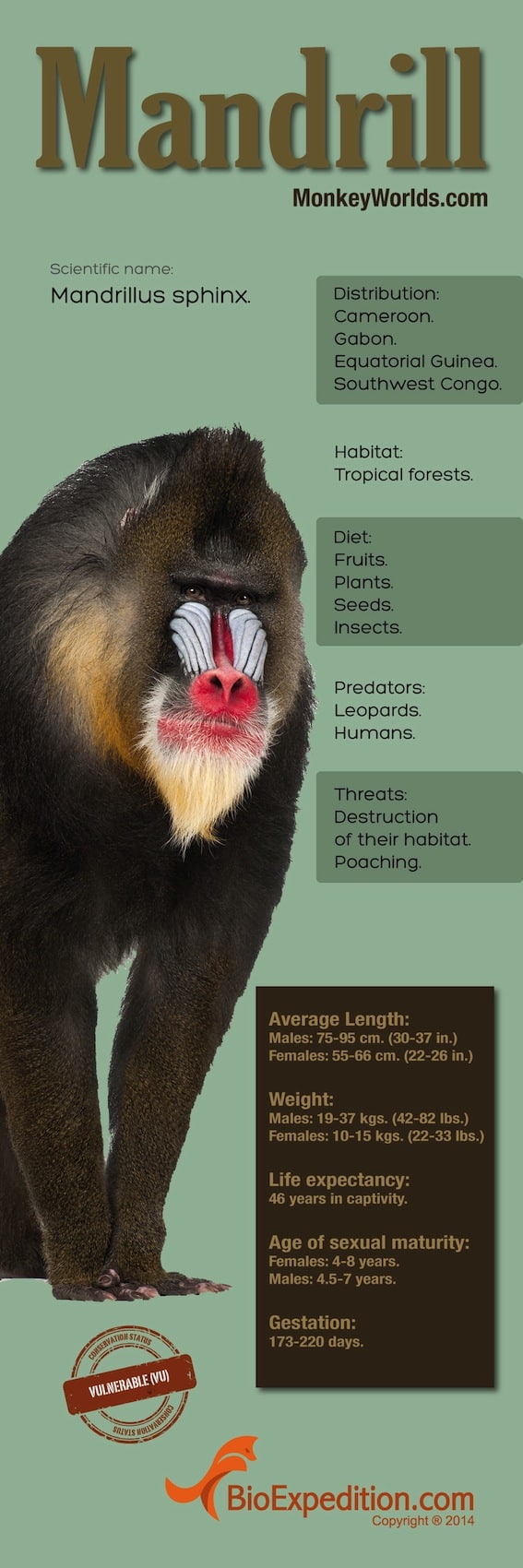
Vervet Monkey – Chlorocebus pygerythrus
Introduction
The Vervet Monkey is an Old World classification. There are 5 known subspecies that have been identified. They have a very unique appearance to them which helps them to be separated from other types of Monkeys found in the world.
Description
A black face with white fringing is how the Vervet Monkey is identified. The rest of the body is a shade of gray. The males are typically much larger than the females. The males can be from 8 to 18 pounds with 12 pounds being the average. There are approximately 1 ½ feet long. Females weigh about 7 to 12 pounds but the average is 9 pounds. They are usually just over a foot long.
Distribution
You will find the Vervet Monkey spending most of the time in the trees. However, they do go to the ground in order to find food. They are found in many areas of Africa. Ethiopia and Somalia are common areas. They aren’t found in the Western parts though. They are known to live along the savannah, the rivers, the woodlands, and even in the mountains. They do well in various terrain and they are highly adaptable. They can live in cultivated areas.

Behavior
This particular type of animal is able to be active both during the day and the night. They are very social and the groups can have as many as 40 members. They have a pecking order though that helps with the overall social structure. They use a variety of calls and they young are encouraged to do them from a very young age.
The mothers though have been seen punishing their young for being playful though. For example they can give the wrong call on purpose to watch the other group members react.
Diet /Feeding
There are plenty of types of foods that the Vervet Monkey will eat. They enjoy fruits, figs, leaves, and flowers. They will eat both bird eggs and young chicks that they find in nests. They will also consume insects and bugs such as grasshoppers.
In areas where humans live these Monkeys will also eat bread and various types of crops. Maize is one of the most common that they will consume. This has created some tensions between humans and the Vervet Monkey.
Reproduction
The Vervet Monkey is mature at about 2 ½ years of age. In the wild they tend to mate during the times when food is plentiful. In captivity there is no set mating period. It takes about 165 days from conception for the young to be born. There is typically only one baby born at a time.
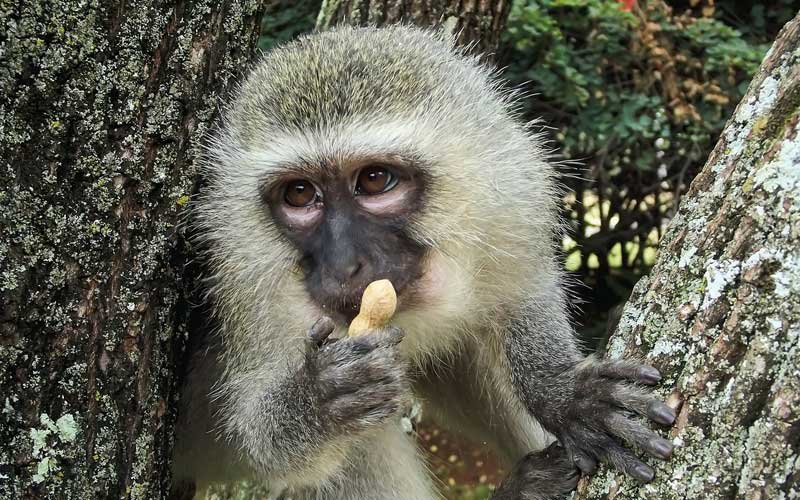
The young are well cared for and the mother won’t have another baby for a few years as long as she has one to care for. If something should happen to her baby though she will mourn the loss. She will also strive to get pregnant again to rekindle that bonding experience.
Conservation
In spite of the fact that the Vervet Monkey can do well in various habitats they are continually killed by a humans. They have died due to electrical wiring that the humans have had in place. Farmers trap and kill them so that they don’t consume the products they are using.
These Monkeys are often used for bushmeat. They have also been commonly captured to be used for various types of laboratory experiments. Studies show that they have been continually dropping in numbers. Conservation efforts include finding ways for the villagers and these Monkeys to find a better balance for living with each other.
There are programs to help the orphaned Vervet Monkeys too so that they won’t die. This can occur if their mother has been trapped or killed. There are efforts in place to make poaching of them illegal in Africa as well. However, there simply isn’t enough manpower to take care of all the activity that occurs there both during the day and at night.
Squirrel Monkey – Genus Saimiri
Introduction
The Common Squirrel Monkey is one that gets its name for looking very similar to the Squirrel. They are part of the New World Monkeys.
Distribution
The tropical regions of South America is where you will find the Common Squirrel Monkey. They are spread out there all over the place so you will find them in Bolivia, Venezuela, and many other places. A population of them was introduced in Southern Florida about 10 years ago. They are doing very well there. Some have been located in Rio de Janeiro too in the last year. It is believed they may have escaped from an illegal pet trade capture.
They are usually found in the middle of the canopy of the rainforests. However, they will move up or down to find food and shelter if they need to. They enjoy the wetter regions where there are marshlands and swamps. Yet they can also be found in the savannahs so they are highly adaptable Monkeys.
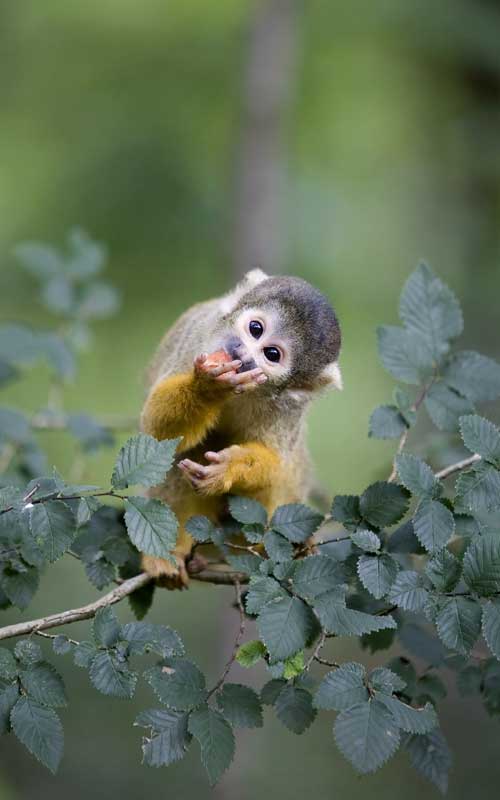
Behavior
There is a good mixture of males and females that interact in the Common Squirrel Monkey groups. However, they have groups that depend on their role. For example the mothers of young spend time with each other. The adolescence will be around their peers. The adult males often group around each other and act out. When mating season is upon them though the males will be very aggressive towards each other.
The entire group is very social and depend on each other for protection. They are very vocal and have a variety of different sounds and non verbal cues that they use to bond with each other. The males often act in ways that try to impress females and that is why they will lavish them with attention or grooming efforts.
There can be groups of up to 500 of them in some places. As a result the social groups and structure has to be very organized. What may look chaotic to us though does work very well for this particular species of Monkey.
Diet /Feeding
Tree Frogs are part of the diet for the Common Squirrel Monkey. They also consume insects, bugs, fruits, leaves, and twigs. They will eat what they can find in various locations without hesitation. Such as diverse diet makes it easier for them to thrive in a changing environment.
Water is something they need and they will get it from puddles on the ground. They also get lots of water from the trees and from the foods they eat. Nectar is something that they drink as well.
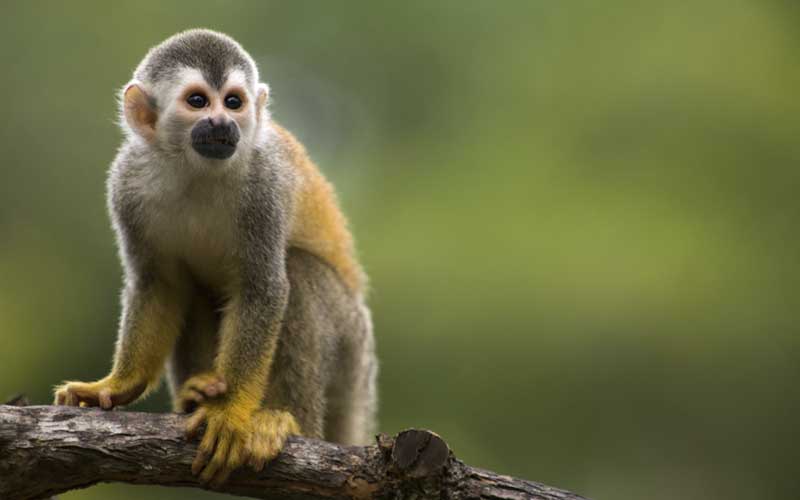
Reproduction
The cycle of mating for the Common Squirrel Monkey can depend on what location where they live. They will typically mate when food is plentiful though. Females are very picky about who they will mate with. Sometimes an entire group of females will run a male off and none of them will mate with him.
The young offspring of the Common Squirrel Monkey are more independent than those of any other Monkey species. Instead of spending all of their time with the mother they will venture off alone or with small groups of other young. This type of activity though is part of why so many of the young die before they can reach the age of maturity.
Conservation
The Common Squirrel Monkey doesn’t seem to be at risk right now of a future. There are concerns in some locations about their habitat being destroyed. These Monkeys are sometimes captured to be sold as pets or used in laboratories. However, they seem to be doing well and their numbers haven’t gone down much in the past several decades.
Spider Monkey – Genus Ateles
Description
There are 7 known sub species of the Spider Monkey. They belong to the class of New World Monkeys. They are believed to be the biggest of all the different Monkeys in that particular class. They can be used for various types of lab experimentation too and often are. This is because they are closely related to humans and there seems to be an abundance of these Monkeys.
Anatomy
With extremely long limbs the Spider Monkey can resemble a spider in many ways. That is where the namesake for it comes from. They may weigh up to 20 pounds with thin dangling limbs that are very strong. The tail is also very long and they have the ability to pick things up and hold them with that tail.
This is one of the few species of Monkeys in the world that don’t have thumbs. Many people don’t realize that as they think all Monkeys have opposable thumbs. They can be found in a variety of colors. Those colors often depend on where they live as well as what sub species they belong to. Such coloring can include shades of white, gold, black, brown, orange, and red.
These are very fast and agile Monkeys. They also have thick fur all over the body except for on their faces. There are legends about the Spider Monkey being evil but many experts believe that many people were just afraid of the physical appearance of this very peculiar animal.
Evolution
Ancestors of the Spider Monkey fall into the Pleistocene group of species. Fossil remains dating millions of years ago show that they were once in Cuba and Spain. It is possible that Native brought these Monkeys when they came to the new world. By doing so these Monkeys had to adapt to a new environment. Their bodies had to change in order for them to make the necessary adaptations.
The evolution of the Spider Monkey is very hard to determine. Dental elements can’t be used from the fossils as the shape and size of them can be the result of the foods they eat and not the fact that they changed in design though the process of evolution. The development of the collar bone though which early fossils don’t have is of great interest to many researchers.
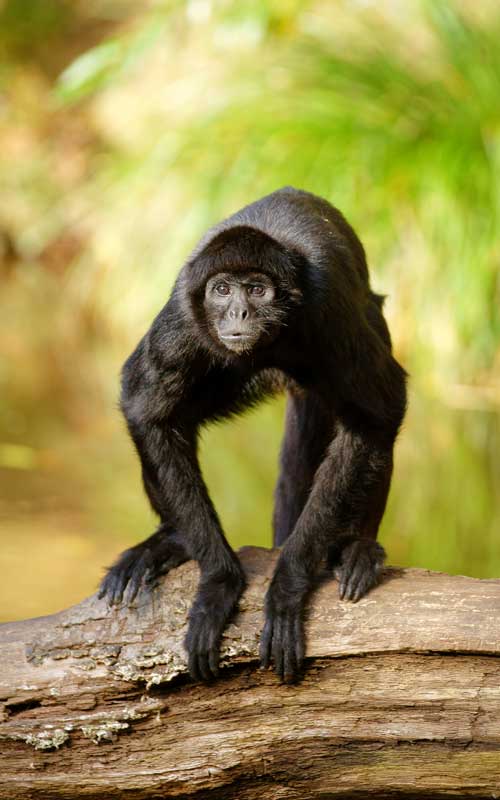
Behavior
The spider Monkey plays a very important role in their natural habitat. They are one of the prime spreaders of the seeds from plants, flowers, and fruits. Without their help it would be extremely hard for such sources of new vegetation to grow in the forest areas.
These Monkeys live in groups of approximately 35 members. They are lead by a female who decides how large the group will get to become. Where there is lots of food and shelter she won’t mind it growing. She may have to decide that the group has become too large for the current environment to handle. If that is the case she will break them up into smaller groups and they will separate. By doing so there is a better chance that more of them will be able to thrive.
The Spider Monkey is well known for being a chatterbox. They depend on their vocalization for warning each other of problems, for bonding, for protecting their young, and even for protecting their environment. They are able to move quickly and will do so in order to stay safe.
Habitat and Distribution
Today the natural environment for the Spider Monkey includes the Southern tip of Mexico and areas scattered around Brazil. They live in areas that offer a huge rainforest so that they have plenty of home range area to cover. They look for regions that offer a canopy over them too. They try to find moist areas to meet their needs but will live in dryer locations if they must.
They like to be in areas that haven’t been disturbed. That can be tough though with humans around and taking over many locations. When areas have been fragmented by humans these Spider Monkeys may no longer want to live there.
There are many of these Monkeys living in captivity as well. They are huge attractions at zoos and draw in crowds. Their presence also helps to spread the word that protection of these Monkeys and many others is necessary if they are going to be able to survive into the future.
Diet and Feeding Habits
The Spider Monkey depends heavily upon fruits found in the natural habitat for their diet. Only about 10% of the foods they consume are anything other than fruits. They don’t nibble on these fruit items though. Instead they will open up their mouths and swallow them completely. Their digestive system is designed to be able to handle this with ease. It reduces the amount of time it takes them to look for food.
What is very interesting is that the Spider Monkey groups will have patterns that they follow for feeding. The dominant female will be in charge of when these feeding times occur. She will try to keep them on a schedule as much as possible. They typically will feed a couple of times as day.
When they have little fruit to consume they will try to find sap. They can also consume bark from trees. They have sharp nails and use it to peel away the outer layer. Then they can find moist elements inside of it that can sustain them until better food supplies are located.

Reproduction
There is no set mating season for the Spider Monkey. The females are in control of when it will happen though. Studies show that when they have enough food they will go into an estrus cycle. If they aren’t getting enough food though they aren’t going to mate at all. This is why it can be tough to get the numbers back up out there in the wild for them.
The females are very particular about the male in the group they will mate with. They may turn away several of them before selecting one. After successfully mating it is about two moths later when the baby will be born. It is very rare for twins to arrive. The young are going to be well cared for by nurturing mothers and group members. They will feed from the milk of their mother for about 10 months.
The young will stay very close to their mothers until they are about 3 years of age. At that time both the males and the females have to leave. They will have to go find another group to live with or they will create one of their own.
Predators
There aren’t too many predators of the Spider Monkey. The main ones they have to be worried about are Eagles and other types of birds. Owls and Hawks often feed on the young so when they get older there is less of a danger. There are various snakes in this environment. Some of them kill the Spider Monkey with poison and others suffocate them.
In many areas the Jaguar is a prime predator of the Spider Monkey. They are amazing hunters and they are able to sneak up on them. They can also quickly climb into the trees without any problems. The biggest problem for these Monkeys though are humans. They continue to deplete the forest of trees and that is taking away the natural habitat for the Spider Monkey.
Monkey Habitat and Distribution
The distribution for the Monkey covers may regions around the world. They tend to live in forest regions where they have lots of trees around them. Some of them live in the savannahs though or in the mountain regions. There are species of Monkeys that only live in trees. Others live in the trees as well as on land.
Monkeys move around their home range a great deal. They travel daily to look for food. They won’t stay in a nest for very long so they don’t create anything elaborate. They use their bodies to help them move rapidly around looking for sources of food. As they do so they spread seeds from plants, flowers, and fruits. This enables their environment and natural habitat to continue rejuvenating.
The evergreen forests are home to a variety of different species of Monkeys. The Mangrove forest regions can also be where they are found. Studies show that the amount of habitat that these animals have has been cut by at least 30% in the past 25 years. That is an alarming rate and means that they really have no where to go.
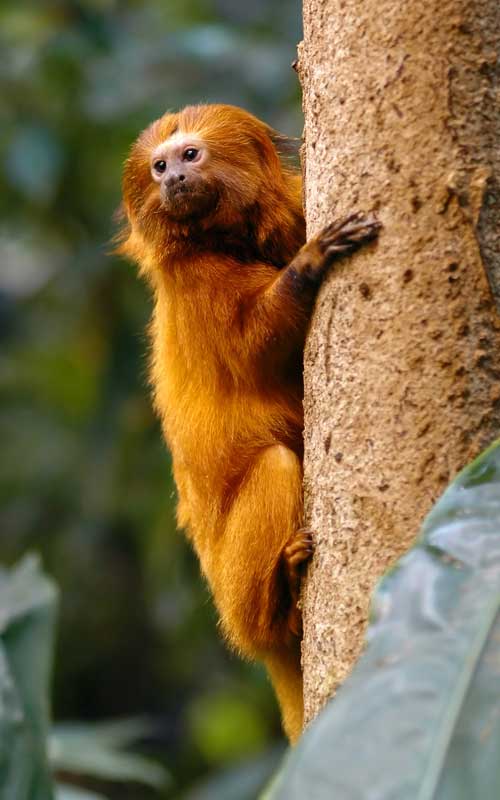
Since Monkeys are very intelligent they are able to continue to adapt to changes in their environment. This is why places where they were once found are now empty. They have had to venture further to find food an shelter in order to survive. The introduction of new species of Monkeys to new locations though can upset the balance of an ecosystem that already exists there so the issues are very complicated to solve.
Another problem is that with many Monkey species the males have to leave when they reach the age of maturity. In some instances the females do as well. This is all part of nature to make sure that inbreeding isn’t taking place regularly in the groups. However, where are those that leave their place of birth going to go? They have too much competition from aggressive groups that won’t accept anyone else coming in. Too often they die due to predation or a lack of food in the regions where they end up.
The Monkey habitat out there has continued to be depleted by large chunks all over the place. Humans have built roads in the center of forests, they have cut them down completely for logging. The need for land to be used for agriculture, building homes, and businesses has also resulted in many locations being completely stripped away.
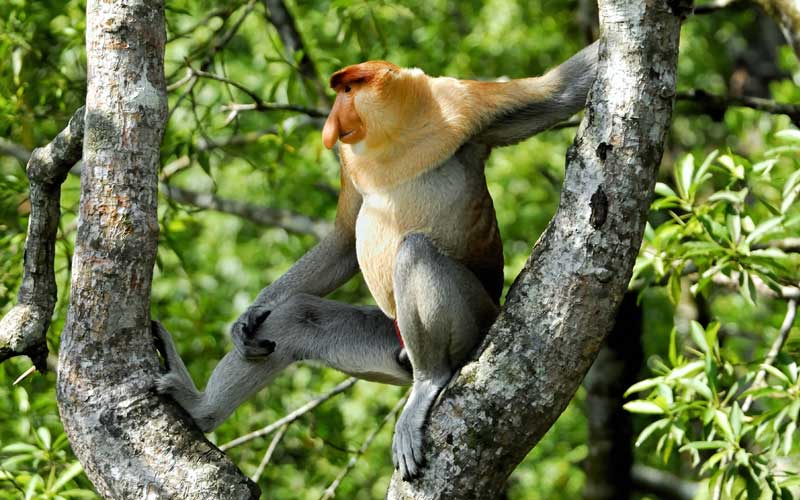
As a result many species of Monkeys are in dire need of conservation efforts. They have been hunted and they are being destroyed by poachers. Sometimes they are stolen and then sold for money. Regardless there needs to be tough laws in place to protect them in their natural habitat. If we don’t get such methods in place then many of the Monkey species out there won’t be able to survive much longer.
Most species of Monkeys do very well in captivity. They are able to thrive there with the right conditions. They need to be around others though so that their need for socialization can be met. They also need to have challenges that will keep them mentally busy. Otherwise they can become aggressive and they can destroy things around them.
Yet the answer to helping the Monkeys to survive isn’t just to put them all in cages at the zoos. There are some refugee locations that have protected lands. The Monkeys can live there and not be harmed. Even so it is hard to get funding for such establishments. The ongoing cost of maintaining the home for the Monkeys is extremely high.
Rhesus Macaque – Macaca mulatta
Introduction
The Rhesus Macaque is also known as the Rhesus Monkey. It belongs to the Old World category and is among the best known.
Description
These are small Monkeys with pink faces that don’t have any fur on them. They may be brown or gray in color. They have a long tail that helps them to stay balanced and for leaping.
Distribution
The Northern portions of India are where you will find the Rhesus Macaque. Thailand, Vietnam, and South China are just a few of the places where they are found. They have the largest geographical location of any primate in the world other than humans. They enjoy open areas that are arid. However, they also live in the mountains at high elevations. They can also live in wooded regions as they have a diverse ability to live in many habitats.
In 1938 a large number of them were released in an area of Florida. They were moved there by a tour guide boat operator. It isn’t known how many of them remain though in that environment. However, most people believe that they were able to adapt to this new environment. The details on the story are hard to find though and you will find many different versions of the events online.
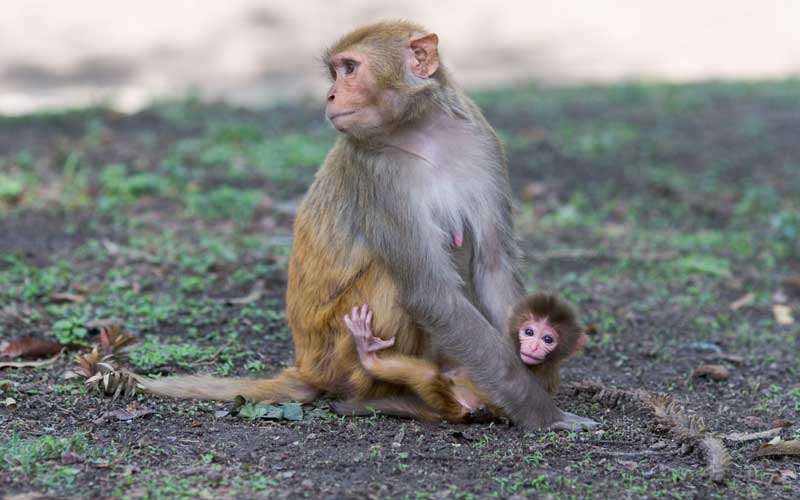
Morgan Island off of South Carolina is known to be home to some Rhesus Macaque that were deliberately moved there. This does indicate that they do very will in any type of environment.
Behavior
Swimming is a common event for the Rhesus Macaque. They do it to help them cross between the islands. The young can swim when they are just a few days old. They are often found to have drown though in areas where the waters was moving just too fast for them to swim. They are active both during the day and at night. They will live mainly in the trees but also on the land.
The groups can have as many as 40 members, with there being about 4 times as many females. There is a complex hierarch that is through the females. Her young will have their lineage in the group based on hers.
Diet /Feeding
Pine needles are part of their food supply. Roots, small insects, and leaves also make up their daily dietary intake. They are able to store food in the pouches of their cheeks. In many areas they have been known to go to humans for food that has been left out for them. They remember where to go for it though so now it has become a huge problem. Now villagers are trapping them and killing them to get them to stop coming around.
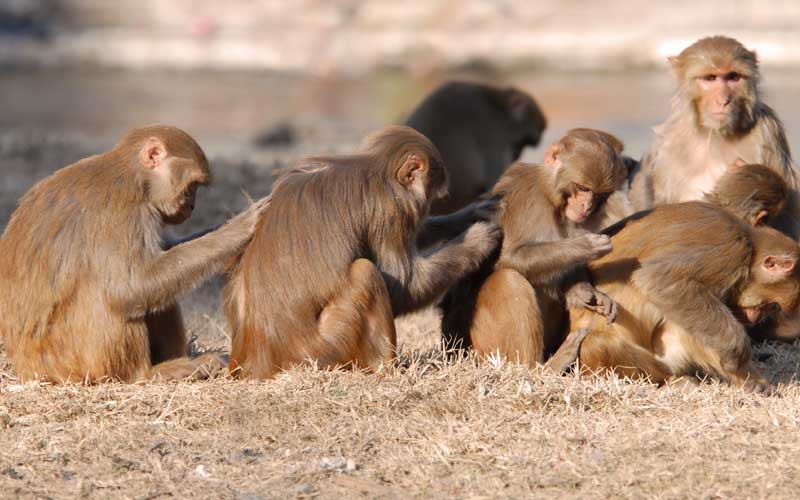
Reproduction
There isn’t a specific time of year for mating to occur with the Rhesus Macaque. As long as they have enough food and shelter it will be taking place. The females are mature around 3 years of age. It is about a year later for the males. After mating it takes about 164 days for the young to arrive.
They are well cared for by their mothers. They are taught how to be important members of the group. They are encouraged when they find food and when they call out to warn other members of dangers.
Conservation
In many areas the Rhesus Macaque isn’t welcome. The stories of the villagers talk about young children being taken by them even though such an event has never been witnessed. They will steal food from the villagers and that can make them very angry. The numbers of them aren’t well known but they aren’t believed to be endangered at this point in time.
Pygmy Marmoset – Cebuella pygmaea
Description
There are many names that you may hear the Pygmy Marmoset called by. They are known as the Pocket Monkey, Little Lion, and the Dwarf Monkey. It is all one and the same though regardless of the terminology being used. They are the smallest of all the Monkeys, and one of the very small primates in the world. They weigh less than 5 ounces when fully mature. There are 2 sub species that are known to exist.
Anatomy
Even though this Monkey is very small it has a body that is fluffed up. They are round and appear to be very fat. They really aren’t though but instead they are offering a natural means of helping them to look larger. They use this mechanism as a way to help them deflect being easy prey. They have the ability to cling to trees due to their sharp claws. They have a visual characteristic of tufts that grow out the sides of the face by the ears. They grow in all directions and get longer as the Monkeys get older.
Evolution
Their brains are now much smaller than that of their ancestors. Yet they are very small primates? Many experts believe that the brain may have consumed too much of their energy. Perhaps with less food readily available they were able to make changes in the area of the brain so that they could save their energy for survival. This is only a theory though and something that has yet to be proven beyond the shadow of a doubt.
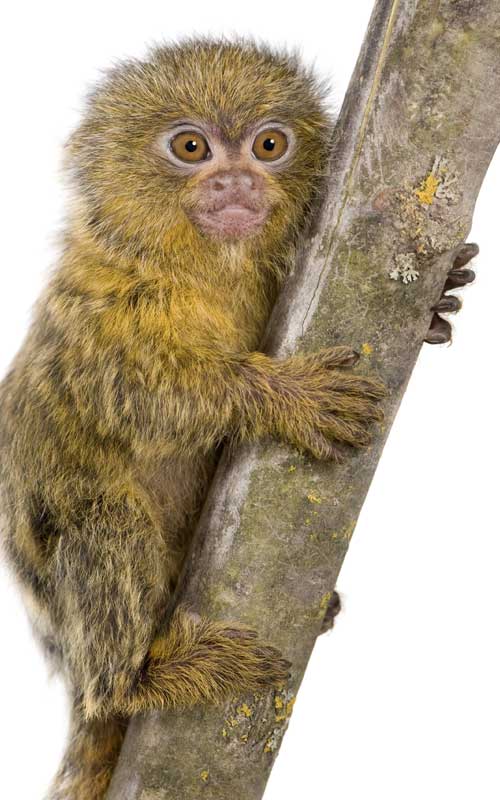
Behavior
Communication is big part of the social aspects for life as the Pygmy Marmoset. They use their vocal calls to chatter, to tell of danger, to encourage mating, and to encourage their young. They make clicking sounds in addition to loud calls. They can make short calls for those group members close by. They can also make long calls for those that are further away.
These Monkeys don’t live in large groups, they will have 12 members at the most. They really do enjoy bonding and spend all their free time with each other. There show a great deal of sadness when one of their members dies. For the most part they are timid and get along with each other well.
They can be aggressive with each other if they need to. Yet they will fight to their own death if they have to in order for them to defend themselves and others in the group. Researchers still want to conduct more research in the area of the behavior of the Pygmy Marmoset. However, it is very difficult to do so without upsetting their natural environment.
Habitat and Distribution
You will find this species of Monkey living in a wide variety of areas. They include Columbia, Brazil, Ecuador, and parts of Bolivia. They will live almost all their live in the trees. It is very rare that they will be found on the ground. They are hard to pinpoint in their environment too due to how small they are. They blend right in and can stay well hidden.
They live in the very high elements of the trees too. They are often covered by a vast canopy of leaves and foliage there. They place their nests at the edges of branches so that it is hard for other living things to reach them.
Diet and Feeding Habits
The diet of the Pygmy Marmoset is very different from most other species of Monkeys. Theirs consists of sap and gum. That is what they will survive on if they are able to do so. They need a diet that offers them high amounts of carbohydrates. They may consume plants, fruit, and insects if they can’t get enough sap or gum.
You may be wondering how they are able to get the sap out of the trees? They have a very good system in place. They use sharp teeth and use them to penetrate the wood. Then they can drain the sap from inside. They are very patient with this process as it can be time consuming. This is why they may take many hours a day to feed.
Reproduction
There is no particular time of year for the Pygmy Marmoset to take part in mating. They can do so at any point in the year. They will be ready to mate as long a they have enough food and shelter around them. Yet when their natural habit is being destroyed those things aren’t always there. This means that they are being destroyed in numbers and that it is also very slow for them to continue adding new offspring.
There are usually a set of twins born to the mother when successful mating has taken place. There can be three or four of them though as well. These young are demanding in ways that other Monkey babies aren’t. They can be very fussy and need constant attention. They can’t eat much at once but they can get hungry every couple of hours. This makes raising them very hard on the mothers just like human babies can be for their own mothers.
There is a very high mortality rate of the young Pygmy Marmoset Monkeys. Trying to provide enough milk for multiples can be tough. There is also the risk of them falling out of the nests or off the body of the mother. Only about 25% of the young will live to reach the age of maturity.
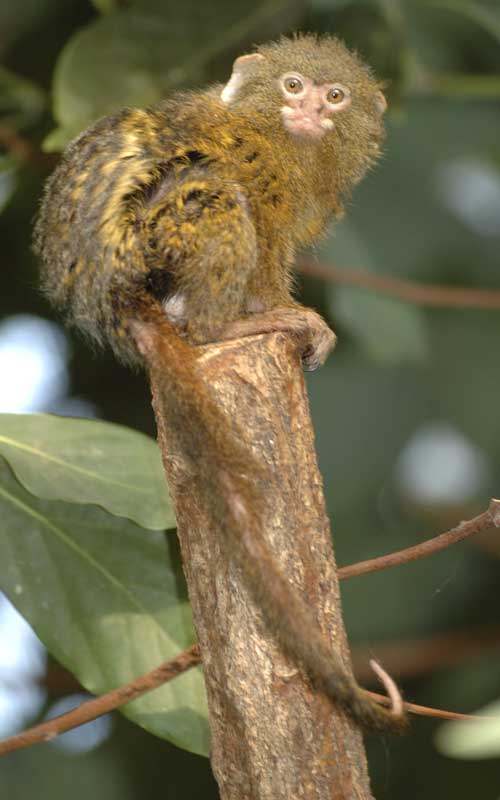
Predators
There are a few predators that the Pygmy Marmoset has in their natural environment. The specific ones will depend on the location where they live. Raptors are a type of bird that can come into the canopies and consumes them. This includes Eagles, Hawks and more. They have excellent vision and sharp claws so it is almost impossible for them to escape.
Snakes live in the same trees as these Monkeys do. Some of them are very poisonous. They will kill their prey by paralyzing them with the venom and then eating them. Others will coil around the body of the prey and suffocate them. Both of these types of snakes live in the regions with the Pygmy Marmoset Monkeys.
Wild cats are able to climb high into the trees. They have bodies that are build for such movements so it is easy for them. They are very skilled hunters and find these small Monkeys to be a very good meal, especially when they are struggling to find larger prey.
One of the ways that the Pygmy Marmoset defends itself against snakes and wild cats is to place its nest far out on the very thin and light branches. They are small and weigh next to nothing so they are secure there. Yet these larger animals are too heavy for the branches to hold them. They aren’t going to put their own life on the line to get a meal.
Humans are a huge problem for the survival of these delicate Monkeys. They continue to destroy their natural habitat. They also continue to take them and sell them as pets around the world. There are efforts in place to protect them but that still hasn’t stopped those with an agenda of their own from proceeding.
Proboscis Monkey – Nasalis larvatus
Introduction
The Proboscis Monkey is also called the Monyet Belanda Monkey, which means the long nosed Monkey. It belongs to the Old World classification. In the Egyptian Culture they were worshipped as a very unique animal and believed to be special to the gods.
Description
The long nose if this Monkey is a very distinct feature that separates it from all other species. In fact, when people first noticed it they didn’t even think it was a Monkey due to the look of it. The males have a nose that is even larger than that of the females. It is believed that a larger nose is going to attract females. The nose can be up to 7 inches long.
The males can be up to 56 pounds with the females barely about 20. This difference is larger than with any other primates in terms of their size. They have a reddish brown coloring and the limbs are gray in color. These Monkeys have a very large stomach too.
Distribution
The Island of Borneo is the known location of the Proboscis Monkey. They live in the lower elevations of the forests and around the swamplands. They are found in the Danau Sentarum National Park where they are well protected from poachers. They are well spread out in their habitat.
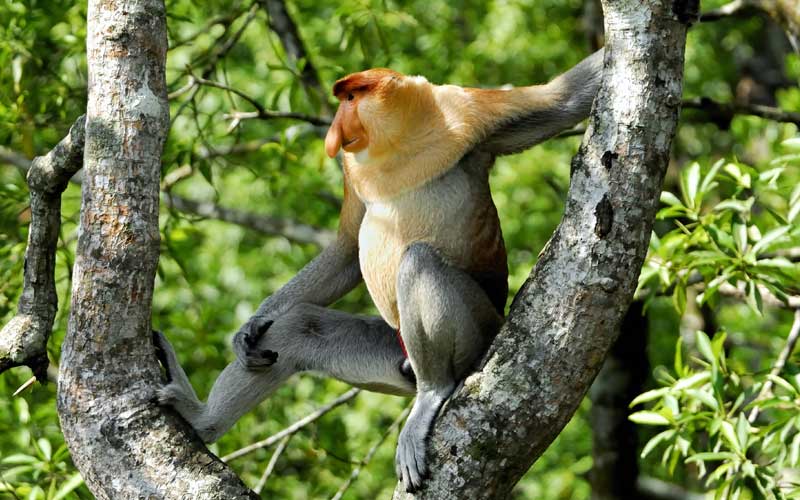
Behavior
The warning calls of the Proboscis Monkey are very loud. It is believed that the large nose allows for the sounds to be bolder than that of other Monkeys. They can live in groups that range from 10 to 30. The Monkeys don’t always stay in the same group though. They can move from one to the next frequently. This is very different from most other groups of Monkey species.
They are able to swim very well even in deep water. This allows them to move from one island to the next. It also offers them a place to cool off and for having some fun playing around. They have been seen walking in an upright position along the trails in the forest. They do so in a single file.
The males create harems within the cultures. This allows the males to have several females for socializing and mating. They also help with the care of the young offspring.
Diet /Feeding
The Proboscis Monkey doesn’t eat more than other Monkeys but it does look like it. That is due to their body shape in the stomach region. They consume mangrove shoots and leaves. They also will consume small insects.
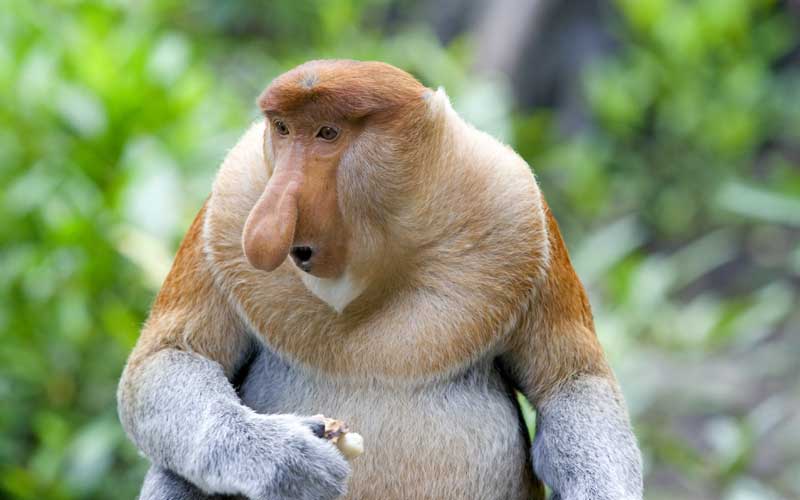
Reproduction
Females are the ones that initiate mating, and it can occur during any period of the year. They will typically do so only when there is plenty of food. The young are born about 160 days after mating occurs. They have a bluish coloring to their face at birth but it will soon turn pinkish.
The males will have to leave the group when they are about 1 ½ years of age. The females though are able to remain for their entire life if they would like to. The Proboscis Monkey has a short life span in the wild of about 13 years. In captivity they may live up to 30 years.
Conservation
The extensive loss of vegetation has led to a steep decline in the number of Proboscis Monkeys in the wild. Today there are only about 1,000 of them that remain. As a result they are strictly protected by the government of Borneo. There are stiff penalties for those that kill them. Still, some poaching does occur and it is hard to track down those responsible for such efforts.
New World and Old World Monkeys
You may have heard plenty about New World Monkeys and Old World Monkeys. Yet it can be confusing to try to figure out what the differences are. Here is some information about them to help clarify the categories. You will also have information about how these two groups of Monkeys are the same.
First, some history about when this all started. It is believed that approximately 40 million years ago there was a significant split among the Monkeys in the world. They New World Monkeys were living in South America and the Old World were living in Africa along with the Apes.
It is believed that the New World Monkeys began the process of migrating to South America. They may have floated there on rafts that they created out of various forms of vegetation. Giving the high level of intelligence of these animals it could have been the result of any number of things that they used to cross the Atlantic Ocean.
Of course the level of water and the overall vegetation was very different at that time than it is today. You can’t imagine them trying to do something like that with today’s design but it would have been very possible back then. Odd features such as a stub for a thumb or even no thumbs are also common among Old World Monkey species. You don’t find those variations with the New World species.
Old World Monkeys tend to be larger in overall size. They have fingernails that are flat instead of sharp. They also have nostrils that are narrow and point downward. The checks feature padding in them. They also have buttocks without hair but with padding that they can sit on. They can be found both in the trees and on land. Two common Monkeys that fit this category are the Baboon and the Snow Monkey.
New World Monkeys spend most of their time or even their entire lives in the trees. This is why they need longer nails that are also very sharp. They don’t have the cheek pouches or the padding on the buttocks. They have wider nostrils that are round in shape. Two common species here are the Callimicos and the Marmosets.
Old World Monkeys are only able to see the world in Black and White. However, New World Monkeys see in color just like humans do. It is believed that a genetic mutation over time is what allowed for this significant change to occur. However, all Monkeys seem to have good eyesight regardless of if they are able to see color or not.
It is believed that the amazing care we see the Monkey young receiving is part of the New World Monkey habits. This is an area of great debate though. There are many experts that believe all primates have the desire to be able to care well for their young and to form strong bonds. Others though feel that the intelligence of these animals matured over time as did their parental instincts.
Regardless of whether they belong to the New World or the Old World, all Monkeys are fascinating creatures. They all have tails, fur, and they have large ears. They may be different sizes and they may have different habits when it comes to their social structure. Yet there is no denying that they all have characteristics that will forever bind them. Some of the Monkeys have been able to evolve over time and continue adapt to new environments. Others though tend to have problems due to their natural environment being depleted at a rapid pace.
Monkeys in Culture
Monkeys have always been part of popular culture. They are part of very early religions including Hinduism and Buddhism. They are symbols too in order to ward off evil. The see no evil, speak no evil, and hear no evil shows three Monkeys. One has a hand over his eyes, one a hand over his ears, and one a hand over his mouth. This continues to be a very popular symbol people have to remind them to be cautious with what they take part in with other members of society.
The most historical Monkey is Albert II who was the first one to go to outer space. This occurred in 1949 and he was a huge part of the success of the space program at that time. He was also able to be one that was taken onto the moon and out of the spaceship.
Monkeys have a delightful spirit that people of all ages enjoy. That is why they are found in popular culture in the form of characters. One of the most famous is Curious George. He lives with the man in the yellow hat. He has numerous adventures and does get into plenty of trouble. Yet at the end of the day it all works out and he is content. There are books and cartoons about Curious George that many parents also read when they were young or watched on TV.
There have been several movies too with Monkeys as side kick characters. They often add a new dimension to the show that draw in larger crowds. Some of these shows are action packed and others are children oriented. If you have a love of Monkeys though you will always enjoy such shows. Books with fictional characters as well as real ones are very popular. They often have wonderful graphics too that show people different species of Monkeys.
The one movie where Monkeys weren’t shown in a positive light was the popular Wizard of Oz. Instead, they were the culprits to the evil witch and had the ability to fly. They were dark and sinister creatures and showed another side to Monkeys that is hardly ever part of any popular culture. The other time winged Monkeys were shown was on the popular Simpson’s cartoon.
Documentaries that show the live and interactions of Monkeys are extremely popular. They show us just how many of the humanistic characteristics that these primates share with us. They have emotions that are both verbal and non verbal that we are able to observe. Through these documentaries we will find that that they are very intelligent and great care givers.
One of the best bands of all time was the Monkeys. They chose their name due to the fact that they liked to mess around and have fun just like these well known animals. In many ways people have given them humanistic talents. For example there are plenty of stuffed animal babies that children like of the Monkey. They will carry them around and mother them.
There is plenty of art work that has Monkeys in it. Most jungle scenes show them observing what is going on around that area. They seem to be a good leader for the overall ecosystem where they live in such art work. Video games are another sector where you will find Monkeys in popular culture with a new twist. The Monkey is one of the loved animals that draw people to the zoo too. They come to watch them play and interact with each other. When there is a young one around it seems that people will flock to this exhibit all day long.
